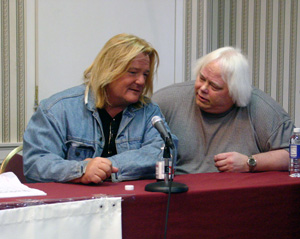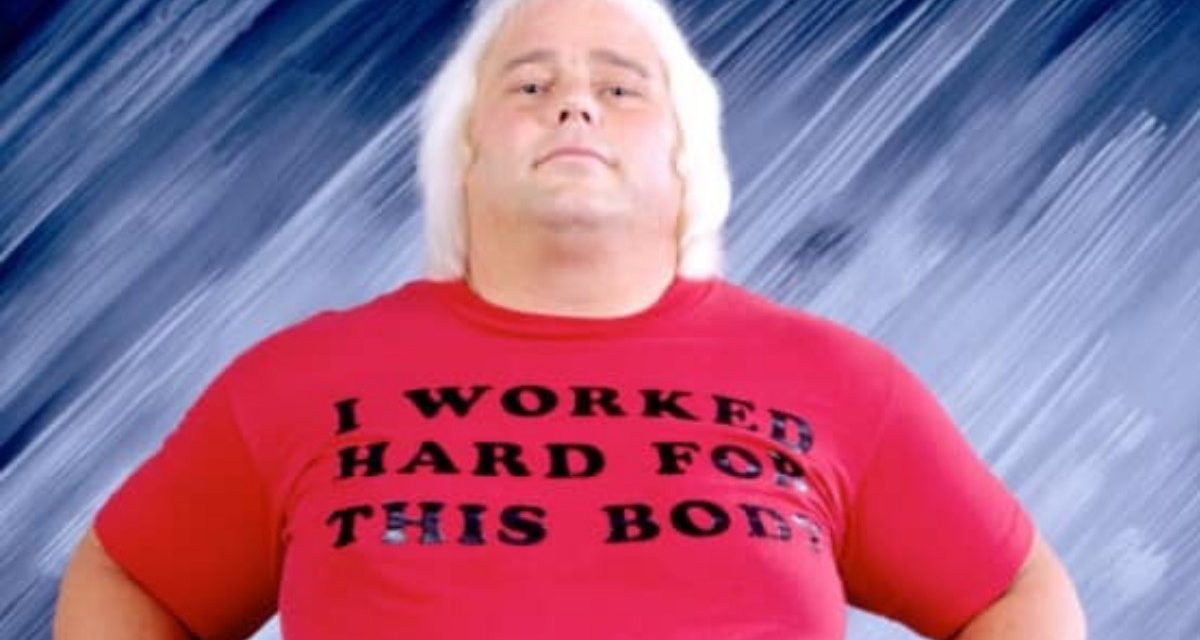This cannot be. Playboy Buddy Rose, contemptible scourge of the Pacific Northwest, practitioner of vile villainy and kilt burning, is talking to dachshunds.
Long distance.
“Presley and Pixie, they’re my babies,” Rose said last month after a swing to the East Coast separated him from his wife, Tammy, and their prize-winning dachshunds. “They were crying when I was leaving. I called home and they knew it was me talking.”

Playboy Buddy Rose (right) chats with Greg Valentine at the recent Fan Slam in New Jersey. -Photo by Steven Johnson
Well, of course. For 30 years, when Rose has spoken, all manner of man and beast has paid heed. With a compelling presence in and out of the ring, Rose, nee Paul Perschmann, carved a niche as one of pro wrestling’s most memorable heels throughout the 1970s and 1990s.
His career, if not his love of dachshunds, will be front and center this week, when the Cauliflower Alley Club (CAC), a fraternal wrestling organization, honors Rose, 51, at its annual reunion in Las Vegas.
“It’s an honor to be associated with all the legends of professional wrestling over time,” Rose told SLAM! Wrestling. “It’s nice to see some of the people that paved the road to help me have a career and some of the people that came after me.”
A fan as a kid in the Midwest, Rose made the transition from sitting in chairs to swinging them after he was trained by legends Verne Gagne and Billy Robinson in their famous “wrestling barn.”
He entered the mat wars in December 1973, going to a 15-minute draw in Wisconsin against another Gagne-trained newcomer, Bob Remus, later known as Sgt. Slaughter.
After initially working in Gagne’s American Wrestling Association and in Texas, Perschmann morphed into the haughty, heavyset Rose for Portland promoter Don Owen in 1976 and immediately became the region’s headlining heel, holding the Pacific Northwest singles title eight times.
While Rose wrestled all around North America, he might be remembered most for his work in those Portland-Seattle area rings, particularly against Roddy Piper.
In 1979-80, Rose teamed with Ed Wiskoski (aka Col. DeBeers; also a 2004 CAC honoree) in a series of brutal tag matches against Piper and Killer Tim Brooks.
Those encounters spun into an unforgettable singles program that reached a true “flashpoint” when Rose stole Piper’s Scottish kilt and set it on fire during a television promo. Piper and Rose tried to settle the score in a serious of bouts that stipulated the loser would have his head shaved.
In fact, the locks of fan favorite Red Bastien fell prey to Rose’s tonsorial skills in the run-up to the Rose-Piper matches. But Piper got the final say when he pinned Rose in a steel cage match in Portland that featured Bastien, now the president of the Cauliflower Alley Club, as special referee.
“Buddy’s a good guy. A real pro, and very respectful of the business,” Bastien recalled.
Rose appeared in the WWF in the early 1980s against world champion Bob Backlund, and was in the first match at WrestleMania I, losing as the masked Executioner to Tito Santana. The reason for the mask – despite the telltale girth – was simple; he said. WWF booker George Scott didn’t want “Playboy Buddy Rose” to lose at WrestleMania.
He spent much of the mid-1980s in the AWA, where he teamed with Doug Somers in a series of bloodbaths against the Midnight Rockers team of Shawn Michaels and Marty Jannetty. A televised match from 1986 still makes the round of tape traders and is considered one of the top matches of the year.
Rose and Somers even captured the AWA tag belts, but Rose looks back on his partnership with Wiskoski with more fondness. The two held the Pacific Northwest tag belts multiple times and twice were world champions in the San Francisco market.
“God love Doug Somers, but when Ed and I teamed up against the Rockers, we had much better matches,” he said. “We both could wrestle technically, and we both could bump great, but we still had completely different styles. When I did interviews I was like the Ray Stevens-kind of barking guy, and he was the educated one, talking with the bigger words.”
So it’s fitting that Rose and Wiskoski, who co-own a wrestling school near their homes in Washington state, will be recognized together at the CAC event. What’s more, a third member of the Class of 2004, Ed Moretti, can attribute his first ring in-ring mauling to Rose.
In 1978, as the U.S. champion in the Los Angeles territory, Rose taunted the crowd in the famed Olympic Auditorium, claiming he could take on all challengers.
He chose Moretti from the audience and delivered a bloody and convincing thrashing designed to portray himself as a ruthless rival for his real challenger, Hector Guerrero.
“I knew Ed Moretti was going to work with me. I said, ‘Hey, he’s never wrestled, but he knows what to do, so let me have this little thing with him.’
“Now, here we are 25 years later, and with Col. DeBeers, whom I first met in 1975 when I was going through Kansas City,” Rose said. “It’s pretty nice the way it worked out.”
Far from being a stereotypical jovial big guy, Rose used his ample bulk to raise fans’ ire. He insisted that ring announcers check him in at 217 pounds (he was a good 40-60 pounds heavier for most of his career) to help sharpen his arrogant, over-the-top persona.
To caricature his character, Rose created the “Blow Away” diet for a series of TV vignettes. He sprinkled some white dust on himself, turned on a fan, and magically “blew away” excess poundage.
In fact, with apologies to Dr. Atkins, the weight-reducing powder was nothing more than Tide laundry detergent.
“I didn’t lose any weight, but I sure smelled a lot better,” Rose laughed. “It was a part of the gimmick.”
Yet Rose was surprisingly nimble for his size. He could perform one-arm pushups and nip-ups, and take more than his share of bumps to help advance the status of up-and-coming stars like the late Jay Youngblood, whom he considered one of the five best wrestlers he ever faced.
“No matter what shape my opponents were in – normally, they were in much better shape looking than me – I was always the all-around athlete,” he said. “The babyface, when he made his comeback, believe me, I was all over the place, falling on my head on the floor, doing the flips in the corner.”
And he was just as willing to stand up to executives who wronged him as opponents like Piper or Jimmy Snuka. Rose caused a stir in 1979 when he publicly dressed down San Francisco promoter Roy Shire during a show at the Cow Palace.
Rose had just returned from a minor disciplinary action by the California athletic commission. Though he had been cleared to wrestle, Shire sent two other wrestlers to the ring to fight for Rose’s U.S championship belt. Rose entered the ring after the first fall and berated Shire’s actions in a very real speech that took many fans behind the happy façade of pro wrestling.
“It was pretty unprecedented for the time, but it was the right thing to do,” he reflected. “And I wouldn’t say my career was affected by it. In fact, I got a lot of support from other wrestlers.”
And he’s likely to get even more when he steps on stage at the Plaza Hotel and Casino at the Cauliflower Alley Club gathering this week.
“I saw parts of the world I never imagined as a kid … New York City, Japan, Nigeria, you name it. I went 30 years without a serious injury. It was a great run.”
BUDDY ROSE STORIES
- July 12, 2009: Tales of Buddy Rose, courtesy Easy Ed Wiskoski
- May 4, 2009: Mat Matters: My personal memories of Buddy Rose
- Apr. 29, 2009: ‘Playboy’ Buddy Rose dies
- March 9, 2009: Santana & Rose reflect on Wrestlemania’s debut bout

